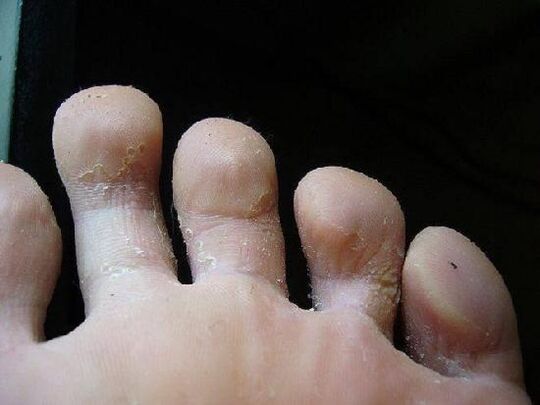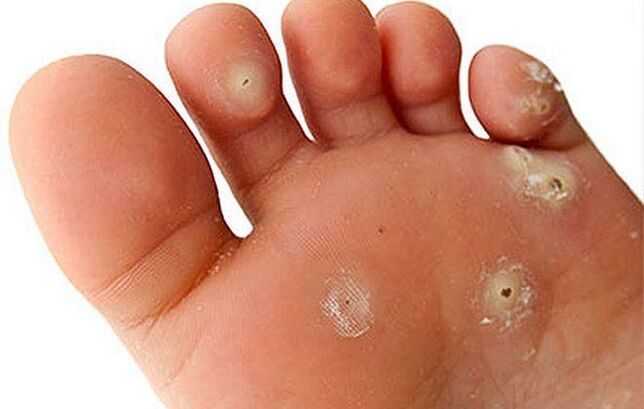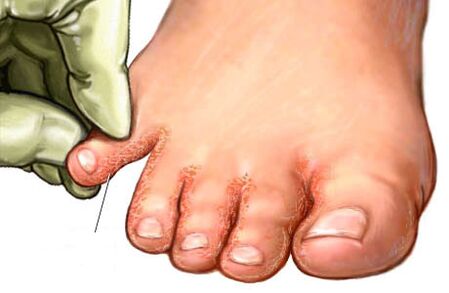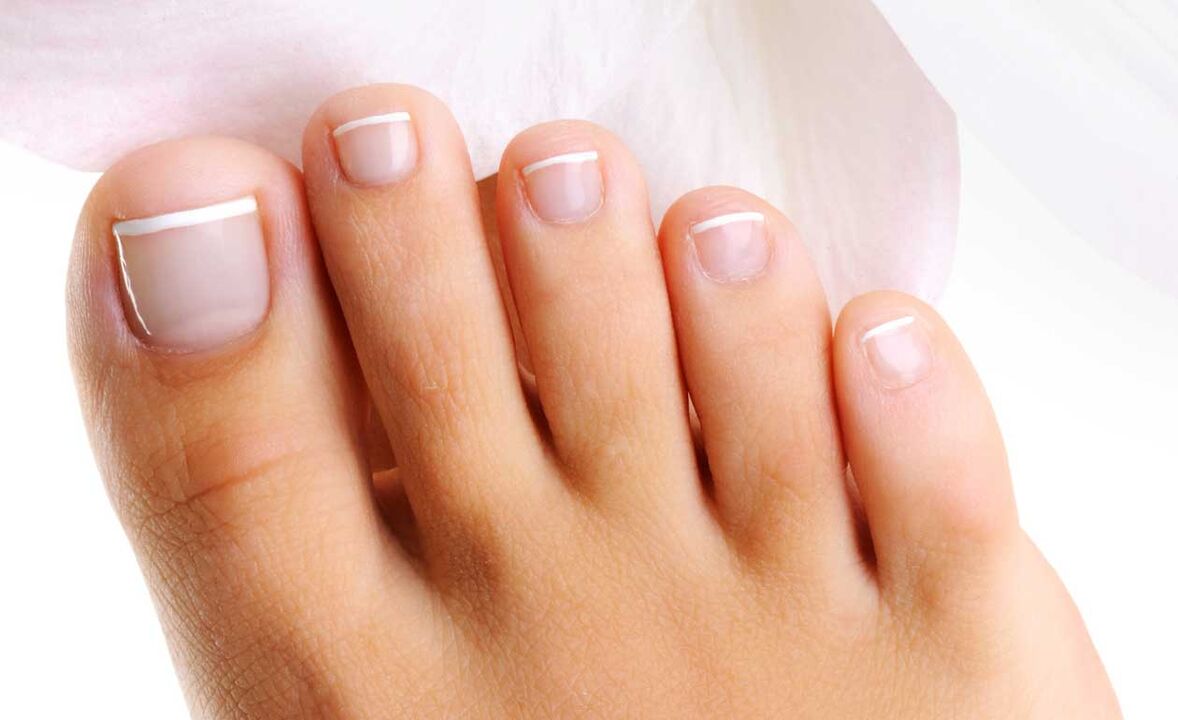The fungus on the feet is a seasonal disease and is most pronounced during the season of wearing closed shoes. Fungal infections of the foot do not attract as much attention as other types of fungi, such as nail fungus. This is because the foot is not visible unless you specifically look at it. And the first, non-strong manifestations are attributed to everyday causes.
The easiest way to test yourself against foot fungus is to sniff your shoes! Bad smell is a sign of a fungal infection. Although the fungi themselves do not emit an odor, they are waste products. . . In addition, waste products from microorganisms established in wounds caused by fungal disease. These are mostly staphylococci. All of this together causes an unpleasant odor on the shoes and feet.
Combing the skin of the affected area leads to the spread of the infection!
If the feet are in warm, closed shoes for a long time, they sweat heavily. A fungus that does not activate under normal conditions, once in an ideal environment for itself, begins to develop actively. That is why the second name of this disease appeared - "The foot fungus". A fungal disease of the foot caused by several types of fungi. And because athletes spend most of their time in tight, closed shoes, they mostly suffer from this mycosis.
Foot fungus is quite common. It causes a fungal infection of the skin areas between the soles of the feet or toes.
Such mycoses can be caused by a type of parasite colony appearing on the feet in an infectious and highly contagious disease called a fungus on the feet.
Fungal diseases that cause extensive skin lesions are provoked by various types of fungi, the nature of which is revealed by the study of the analyzes.

How the fungus manifests itself
On the skin of the legs, the pathology initially occurs in small areas that tend to peel, then the patch spreads with uneven edges and mycosis becomes more pronounced.
The activity of manifesting the symptoms of the fungus on the legs can be lightning fast and can be quite slow. Because it all depends on how strong a person’s immunity is and the type of microorganism that caused the disease.
The types of foot fungus are quite different and manifest in their own way, but if a person has any pathological changes in their feet, they need to find out from professionals what the cause is. Mycologists explain what a fungus is and teach you how to overcome it.
What does a fungus look like?
The foot fungus is accompanied in most cases by the "foot fungus" - it appears as a barely noticeable flaky skin. As the pathology spreads, the color of the skin changes to red and the changes become more noticeable. Furthermore, the foot disease looks like a large area with large dry flakes, sometimes with marks on one side, sometimes on both sides of the foot. The localization of the leg fungus is usually located at the base of the limbs, and the appearance of the limb depends on the degree of development of the pathology.
Differences between species are taken into account, such as:
- a very dense stratum corneum on the base;
- the flakes begin to peel the honey with fingers;
- the skin is inflamed;
- the lesions in the legs also appear to be bubbles.
The fungus formed on the legs seems quite expressive, so one should notice the specific manifestations and consult a doctor.

Causes of foot fungus
What to do if mushrooms appear? First, it’s worth finding out the reasons for its appearance and thinking about exactly where the spores can be picked up and why the body hasn’t responded properly.
About how the fungus begins to form, the reasons that prevent the formation of the pathogenic flora, mycologists say: fungus can form on the feet if an infected person wears socks or shoes and does not wear slippers in places where crowds of people pass, namelyin public baths, saunas and swimming pools because there is the most favorable soil for the bacterial front.
How to identify a fungus on the legs
The development of fungi, mycoses, provokes at a fairly high rate, and such manifestations develop particularly rapidly when there are simultaneously chronic diseases. Foot diseases can be determined on their own, but in order not to confuse any wear and tear on the skin with signs of fungus on the feet, it is worth carefully considering the condition of the covering and how the skin looks under the toes.
The symptoms of fungus in the legs are quite varied, as the types of fungi on the legs are also not only increasingly limited, and each has its own distinctive manifestation.

What does a mushroom look like on its feet
And what the skin fungus on your legs can look like determines what your species is. So to speak, the mycelium leaves your "calling card" on arrival.
Sometimes people with such a medical history don’t even know about it, they just see a cover that’s too dry on their feet, but they mean it has to be that way.
The general symptoms usually look like this:
- the appearance of microcracks;
- mild itching, especially between the toes;
- severe peeling;
- sometimes swelling and pain at the site of erosion;
- rarely, but bleeding occurs.
- deep cracks may appear.
How to cure foot fungus
Treating the fungus on the legs is a long process, but if the preparation stage is done correctly, that is, when it is diagnosed, which pathogen is parasitizing in the body, the therapy can be faster.
Comprehensive treatment of skin fungi is required, using both internally administered drugs and external medical pharmacological agents.
The foot fungus can be treated by careful study of all affected areas, this should be facilitated by a cure.
You should consult mycologists about the treatment of the fungus. They can talk in detail about which drugs can cope well with the disease.
The treatment of foot disease can be divided into several parts. The most important task is to strengthen the most vulnerable areas and rehabilitate the areas affected by the disease. It is important to know that the foot must always be dry and clean:
- and the shoe must also be made of breathable material;
- cotton interchangeable socks should become a good absorbent that collects moisture;
- after the feet have been in shoes all day, they should be rinsed thoroughly and lubricated with a drug prescribed by a special doctor.
It is also good to use special powders to help keep your feet dry.
The next part of the treatment involves the use of antifungal medicines, such as:
- special ointments;
- a cream with a lighter texture than the ointment, which means it has a deeper penetration angle;
- aerosols whose smallest particles penetrate the most inaccessible places.
And although almost all pharmacological preparations for the removal of pathogens are sold without a separate prescription in the retail pharmacy network, nevertheless, the consultation of an experienced specialist will not only not be unnecessary, but on the contrary, will help to have a complex effect on this disease.
The most common reason why treatment does not result is primarily a disrupted treatment regime and improper use of funds.
There are also the following reasons:
- many patients do not understand the severity of the disease and do not accept the proposed treatment;
- about one-third of patients do not seek medical attention at all and occasionally take self-medication that, for obvious reasons, does not bring relief;
- many patients do not believe that an accurate diagnosis of a pathogen type is necessary;
- many stop treatment on their own as soon as the first positive results are achieved.
How to treat foot fungus with folk remedies
You can also treat the fungi on your feet with homemade folk remedies.
You have a good tool, you can do it yourself.
Ointment that kills mycosis of the foot well:
- vinegar essence - 110 grams;
- a raw egg;
- butter - 200 grams (it is better to buy a natural host).
Absorbent scrubbing from the kitchen shelf:
- soda;
- drunk coffee;
- ground oatmeal;
- rice flour.
Such components, which get into the foam, can be an excellent help in sanding the skin of the foot. They are great for exfoliating skin particles and freeing areas to be treated from excess layers.
Compresses with anesthetic solution.
The gauze compression is soaked in an anesthetic solution and reinforced on the foot at night. In the morning, the bandage is removed and the affected areas are treated with chamomile decoction. Repeat for 7 days.
If you study the subject well, the foot disease can be treated with folk remedies and the skin fungus on the legs will go away without a trace, without the possibility of relapse.

Consequences of advanced mycosis of the skin of the legs
The treatment of the skin fungus on the legs must be comprehensive and timely, otherwise the following complications may occur:
- the parasitic elements themselves, as well as the products left over after their vital activity, increase the risk of allergies in patients;
- the course of dermatitis can be complicated by the appearance of eczma and psoriasis;
- as the skin is severely damaged, the infection penetrates unimpeded into the lower layers of the epidermis and provokes the appearance of lymphostasis.
With the athlete's foot, warts appear much more often and hyperkeratosis can develop.
Preventive measures
Foot fungus, or rather its occurrence, can be prevented.
First, it is possible to use ointments and folk remedies as additional protection, and then the fungus is treated, even if it occurs, according to a simplified scheme.
And you also need to complete the following steps:
- eat as prescribed by a healthy lifestyle;
- follow hygiene procedures;
- strengthens the body's immune system;
- take precautionary measures.






























